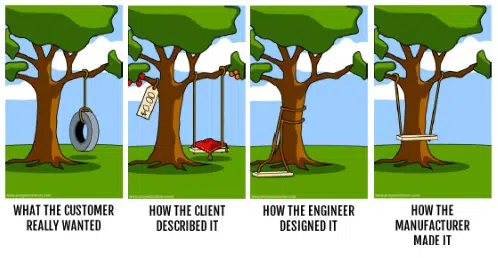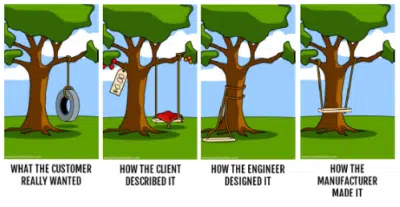Based on your Google search of “How to build an app?” (or “build app how,” or “app building how do it”,) it would appear you have a product idea. That’s exciting! Luckily, you’ve come to literally the exact right place.
Goji Labs is a product and software development consultancy that’s ~humbly~ built hundreds of those things. We’ve created a handy dandy guide for you on how to build an app. Because while it’s not as simple as the WikiHow slideshow makes it sound, it’s also not so difficult with expert development partners.
TLDR; Contents
How to Build an App, Step 1:
Come up with an app or product idea.
Done.
How to Build an App, Step 2:
Learn the risks and how to mitigate them.
We like our clients to know there are basically three types of risks to consider when you’re building an app or founding a company. Of course, not all projects will have all three, but it’s good to be aware of them anyway.
- Product Risk – or, the risk that comes with incorrect assumptions and poor product strategy. These incorrect assumptions can be about the market, user, or product fit. This risk is the most pervasive and critical of the three.
Mitigate by: research, a meticulous product strategy, and an excellent MVP. - Technical risk: the risk that comes with investing in unsustainable or unscalable technical development.
Mitigate by: choosing an experienced, transparent developer with long-term investment in the project. And choosing them with a resource-optimization mindset, not one of cost-minimization. - Domain expertise risk: the risk of developing your product without technically and qualitatively contextualizing it.
Mitigate by: doing tons of research on your industry. But most importantly, choosing the right, long-term development partner with either domain expertise or experience to develop it.
How to Build an App, Step 3:
Choose the right technical development partner.
Doing this step correctly is critical. Who do we mean by the right development partner?
Well, let’s answer the opposite question first. Who’s the wrong partner?
The wrong partner is inexperienced and hired for a one-type prototype-building project. We get it—when you’re first starting, resources are limited. So you may still be working another job or funding the project yourself. That makes perfect sense.
However, choosing a one-time developer and compromising on their experience level is not going to save you money in the long run. On the contrary, lack of long-term investment on their end may mean they build an initial prototype that is not scalable, quality, or won’t get traction. And choosing someone inexperienced may render the same result.
Especially when resources are limited, it’s important to maximize them (hence the “resource-optimizing” mindset)—so don’t simply do what’s most cost-efficient in the moment.
That means choosing an experienced, transparent, long-term technical partner to build your product right—from the get-go. That way, you’ll be able to gain traction on your initial investment and turn that into quicker returns with which you’ll fund future iterations.
The Goji Labs App Development Process
After hundreds of projects (again, ~humbly~), we’ve developed a pretty robust methodology for this whole process. We’ll explain.
How to Build an App, Step 4: Discovery, product strategy, and research
Aligning visions
The purpose of this stage is to mitigate product risk. During discovery, we want to converge our client’s vision with what we see and see it from your perspective. Otherwise, you get something that kind of looks like this:
The Bucket List
From there, we outline what the app needs to do and create a bucket list. Ergo, what are the “must-haves” for launch vs. the “nice-to-haves-but-let’s-wait-a-minute.” This separation is crucial because it decides what is necessary to gain initial traction and in what you should initially invest precious resources.
The bucket list can draw upon a clear understanding of your resources—that is, how much time and money you have to invest in the initial stages.
Identifying the Users
From there, it’s time to identify your target users and their motivations. You can then flesh out your business model (i.e., how you’ll make that $$$) and decide on the best product vehicle (web vs. mobile.)
Research
And then, you can start collecting data on anything and everything to do with your app: industry insights, competitive analysis, market research. At Goji Labs, we also like to explore and vet third-party resources and open-source libraries. There’s no need to reinvent the wheel if it’s a quality wheel—and you’ll appreciate the accelerated timeline and ensured quality and scalability.
Discovery Phase Deliverable:
- A spec (text list) of what the app does
- A defined technical approach to build
- A clear timeline for design and development stages
How to Build an App, Step 5: Design
In the design phase, you want to establish how to best represent and make accessible different features to different users. At Goji Labs, we use an iterative, revision-based approach.
UX Research
We use two methods for UX research:
- Primary – i.e., directly reaching out to prospective users through surveys and interviews.
- Secondary – i.e., competitive research, as well as using available data resources.
Primary research is essential because it gives you tailored feedback to your app idea, specifically. It also gives you a competitive edge by getting you access to data your competitors don’t have.
However, primary research may be limited in reach and scope. This is why competitive research and secondary research is so important. While the information may be available to others, it gives you perspective on your primary data and may widen your reach of information.
At Goji Labs, we know that excellent UX research is the crux of a good app. So we invest in it. A lot. Trust us, it’s better this way.
UX Design
In the UX design phase, our goal is to create high-fidelity wireframe of the app. So that means building a functionality skeleton without colors or branding to define the app’s information architecture. By doing so, we translate the functional requirements into an array of user flows and interactions.
From there, we can move on to branding—establishing the look, feel, and ~vibe~ of the app itself. Finally, we take the branding and apply it to the design direction, where we establish how the app will actually look.
Design Phase Deliverable:
A perfect blueprint for your app.
How to Build an App, Step 6: Development
You don’t learn to fly before you crawl (unless you’re a bird, and neither of us are birds.) So:
Planning
So, the first step here isn’t to immediately begin coding. You have to define the project architecture and design the object model and API. These all have to be built with the greater vision in mind. That means investing your resources in building a high-quality, scalable foundation for your app.
Parallel Building
At Goji Labs, we build our frontend and backend in parallel to ensure compatibility and quality. We do this one module at a time to support constant testing, knowing that whatever module we build now will support the next one in line.
Frequent testing throughout the process
You know those little “useless boxes” where you push a button, and a little hand jumps out and starts the puzzle all over again? Yeah, those are cute as benign pranks. Not in software development.
That’s why we test frequently and throughout the process—to avoid surprises and keep the building process as smooth as possible. In some cases, we also run automated testing. And, when the app is built, we’ll run acceptance testing to see that everything is as it should be.
Testing frequently not only supports quality but ensures transparency. Because you need to know how your project’s build is going.
User testing
During which we test how prospective users respond to the app and whether the usability and workflow are as they should be. This is the time to get practical, primary feedback and use it before launching to the general public.
Development Phase Deliverable:
Your app! Look at it, it’s so beautiful! How built-in-an-iterative-approach it is!
How to Build an App, Step 6: Launch
Launching means creating a production environment and setting up the production server. But at Goji Labs, it also means building an admin dashboard for you—not just your users.
From launch, the cycle starts over again: design, development, testing. We’re pretty obsessive about the iterative process, and what better feedback to get than that from living, breathing users? So this is the time to gain traction and aggregate as much usability data as possible to inform future, even better, iterations.
But the point remains: it’s essential to build the best minimum viable product possible, to gain traction, to access that usability data, to inform future iterations.
______________________________________________________________________________________
This was a lot. We know. But as we mentioned, it could be beneficial to consult product strategy experts who’ll help you put the theory to the rubber.
Coincidentally, hi, we’re Goji Labs—a product and software development consultancy with experience in designing, “rescuing,” and deploying hundreds of products.
Looking to develop a new app or revamp an existing one?
Have any general questions about who we are and our authority on the subject?
Reach us at GojiLabs.com.
– Goji Labs





